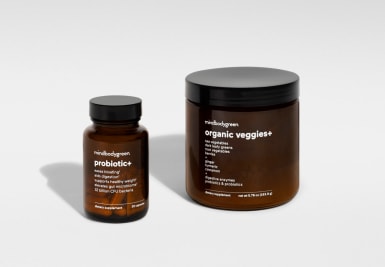In other words, these are live organisms that, when administered in adequate amounts (like in a supplement capsule filled with tens of billions of live bacteria) can bring health benefits to the host (us).* One of the most common, straightforward ways to incorporate more of these good bugs is through a high-quality probiotic supplement. You can also add more probiotic foods to your diet. Here is a list of my favorite probiotic foods, they are easy to find and full of beneficial bacteria: Some popular types of probiotics include organisms like Lactobacillus acidophilus1, Bifidobacterium lactis, Lactobacillus rhamnosus, Lactobacillus reuteri, Lactobacillus casei, Lactobacillus acidophilus, Bacillus coagulans, Escherichia coli strain Nissle 1917, Enterococcus faecium SF68, and the yeast Saccharomyces boulardi. (Clearly there are a lot of options: If you need some help, here’s how to choose the right probiotic.) Think of prebiotics as fertilizer for the good guys. Some examples of prebiotics include FOS, inulin, and flaxseed fiber. FOS refers to fructooligosaccharides2; these are low-calorie, nondigestible carbohydrates, and they occur naturally in certain plants like onion, chicory, garlic, asparagus, banana, artichoke, and many others. Inulins are a group of natural polysaccharides that are made by many kinds of plants and belong to a class of dietary fibers called fructans. Often, inulin is derived from chicory root or agave. One of the most famous prebiotics comes from human milk oligosaccharides3, a key component of human breast milk, as it has been shown to promote the growth of beneficial bacteria in our gut microbiome such as Bifidobacterium. Here is a list of some prebiotic foods that are easy to incorporate into your diet to help feed your beneficial good bugs: Some research suggests that when prebiotics are added to the probiotics4, there is improved viability5 of the probiotic.* This basically means that if you combine probiotics with prebiotic “food,” for those probiotics, it might possibly be more likely to survive and plant its flag in your gut. In other words, you should always be eating prebiotic fiber-rich foods along with your probiotics. So, if you are looking for a way to help give your gut microbiome a boost, you might want to consider a combination of probiotics and prebiotics.* This synbiotic style of eating will help keep your gut microbiome diversity and richness scales more ideal. Your whole body will benefit. Singh is currently the Director of Integrative Gastroenterology at the Susan Samueli Integrative Health Institute at UC Irvine. He is also currently a voluntary Assistant Clinical Professor at UCSD in the Department of Family Medicine and Public Health; prior to this, he has been a Clinical Assistant Professor at UCLA and an Assistant Professor of Medicine at Johns Hopkins University. Singh is a member of the American Academy of Anti-Aging Medicine, American College of Lifestyle Medicine, and many other societies. He is actively involved in the American Gastroenterological Association. He is one of the editors of the textbook of Integrative Gastroenterology, 2nd edition (a Weil Series text) and has written several book chapters and articles. He is dedicated to guiding his clients toward optimal wellness every step of the way, using the most cutting edge technologies to design highly personalized precision based protocols. Towards this end, he founded Precisione Clinic and wrote the book Rescue Your Health to bring the best in preventive medicine to his clients.




